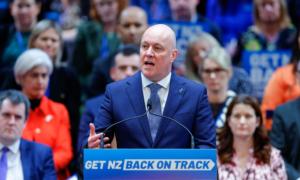New Zealander consumer optimism is at near all-time lows since surveying on the metric began.
A level below 100 signals that the number of New Zealand households that are pessimistic about the economy outweighs those who are optimistic.
In addition, 42 percent of households said their financial position had deteriorated over the past year, while just 14 percent said it had improved.
In February, the Reserve Bank of New Zealand (RBNZ) held the official cash rate at 5.5 percent, and its Monetary Policy Committee warned, “The OCR needs to remain at a restrictive level for a sustained period of time to ensure [inflation returns to the 1 to 3 percent band],” ending any hope of an early easing.
The RBNZ’s indicative forecasts showed little prospect of a rate cut before mid-2025.
While there was some good news in the Consumer Price Index for the March 2024 quarter—annual food prices saw the smallest increase in over five years, and transport costs fell—annual inflation was still 4 percent, with households unable to avoid paying more for other essentials; including rent, which went up by 1.2 percent.

With the cost of essentials—particularly rent, local council rates and insurance—either stubbornly high or even rising, inflation too will remain high, leaving the Reserve Bank’s hopes pinned on the price of other goods and services falling even more steeply than they have.
Trade Me Property’s latest Rental Price Index showed median weekly rent reached a record $650 in March, up 8.3 percent from $600 at the same time last year.
In March, a survey of 48 councils about their planned rates rises found homeowners were facing average increases of 15 percent.
“Council rates have increased steeply over the past year and are likely to rise significantly this year,” the Reserve Bank noted when explaining why the OCR would not be lowered.
And that’s not a recent trend. Between 2002 and 2022 the average increase was 5.7 percent a year, far higher than inflation. In 2023, the average shot up to 9.8 percent.
According to Quashed, a site that allows buyers to compare providers across a range of services, the number of people seeking quotes has tripled in a year.
Further, based on the quotes generated via the site, insurers have been asking for approximately 30 percent more from someone insuring their home, its contents, and two cars than they did last year.
However, there were wide regional differences, with Wellington homeowners quoted just over $4,000 to insure the average house in the first quarter of this year, while those living in Auckland were asked for just over $2,000 and just under $2,900 in Canterbury.
Credit Debt
According to credit company Centrix, more New Zealanders are in debt arrears.The company’s April Credit Indicator report showed consumer arrears climbed to 463,000 in March, up 6,000 month-on-month.
This equals 12.7 percent of the “credit active” population and is 7.4 percent higher year-on-year.
The number of homeowners behind on their mortgage payments in March was 22,100, down just 500 from the prior month.
Consumers’ unwillingness to spend on discretionary items is being felt right across the economy; the value of electronic card transactions in April fell by 0.4 percent across retail and 0.7 percent in core retail industries, compared to the previous month.
In more gloomy news for the New Zealand economy, service sector activity has slumped to its lowest level since the 2021 and 2020 Covid lockdowns.
The BNZ-Business New Zealand Performance of Services Index (PSI) fell 3.6 points in May to 43.0. A figure of less than 50 indicates the sector is contracting.
It was also a larger contraction than was seen during the Global Financial Crisis of 2008/09.
GDP Down, Unemployment And Immigration Up
Gross domestic product (GDP) has recorded four slight contractions in the last five quarters, but this is being buffered by the increase in population over the same period, mostly from migrants. Had that not been the case, the nominal figures would have been far worse.That high level of migration, much of which low-skilled, is going to impact the labour market, particularly at the lower end.
Currently, unemployment sits at 4.3 percent—and that figure doesn’t include the numbers cut from the public sector as part of the government’s 100-day plan, estimated at over 6,000 people so far.
Based on Reserve Bank of New Zealand forecasts that unemployment will reach 5.1 percent, another 26,000 could find themselves without a job before the peak is reached.
And their hopes of getting a job are steadily diminishing: Ministry of Business, Innovation and Employment (MBIE) data shows that online job ads were down 34.8 percent in the year to March and 22.3 percent in the year to April.
Even the government is not immune from the effects.
Lower business profitability means less tax is being paid, so government revenue is tracking $1.6 billion (US$983 million) below forecast.
The government said it collected $1.2 billion less in core tax in the nine months to March than Treasury had forecast in its half-year update.






